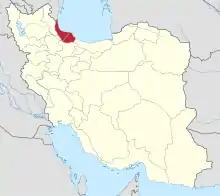Siahkal
Siahkal (Persian: سياهكل, also Romanized as Sīāhkal, Seyāh Kal, Sīāh Kal, and Sīyāh Kal; also known as Sīāhkal Maḩalleh)[3] is a city in the Central District of Siahkal County, Gilan province, Iran, serving as both capital of the district and of the county. As of 2016, the city had a population of 19,924.[2]
Siahkal
Persian: سياهكل | |
|---|---|
City | |
.jpg.webp) | |
 Siahkal | |
| Coordinates: 37°09′02″N 49°52′17″E[1] | |
| Country | |
| Province | Gilan |
| County | Siahkal |
| District | Central |
| Population (2016)[2] | |
| • Total | 19,924 |
| Time zone | UTC+3:30 (IRST) |
History
Siahkal was the scene of the 1971 Marxist Siahkal uprising.
Demographics
Siahkal's population is Gilak and the city's main language is Gilaki language. The majority of the population traditionally followed Shi'ite Islam, some were Jewish or Baháʼí. Many residents are currently secular.
At the 2006 National Census, its population was 15,274 in 4,343 households.[4] The following census in 2011 counted 18,176 people in 5,645 households.[5] The latest census in 2016 showed a population of 19,924 people in 6,796 households.[2]
The Jewish community
There used to be a sizeable Jewish community in Siahkal with synagogue(s) and neighborhoods. The written historical sources on this community are limited, and mostly lost to history limited, as the Gilan province was largely isolated, and mostly ignored in history, but they might have been present since antiquity given speaking the Judeo-Siahkali dialect, as opposed to other Jewish communities of Gilan and surrounding provinces.[6] The community married among themselves and had a long tradition that they were descendants of King David. Some were descendants of Jews of Dilaman, who were ordered by Nadir Shah Afshar in the year 1746 to relocate to Mashhad.[7][8]
The community faced one or several pogroms and mass conversions in recent history based on their collective memory. Possibly, around 1880, there was a pogrom in Siyāhkal in which many Jews were killed, many were subjected to forceful conversion to Islam, and others left the city to live in Rasht (Netzer, Siyāhkal). In the following years, Many of the remaining members of this isolated community converted to Baháʼí Faith, Islam, or joined the Marxist movement. Others gradually left the town, commenced by events of the pogrom of 1880, the Marxist insurrection of 1921, the Soviet Occupation, and then as well as the establishment of the state of Israel in 1948, which prompted immigration of the remaining practicing Jews to either Israel, Rasht, Tehran, or the United States;.[9][10][11] Not much is known of the remaining Converso community who were mostly assimilated into the native population. Islamic Republic's State-Sponsored Conspiracy Theories had resorted to antisemitic tropes of blaming the Crypto-Jews of Siyahkal for the spread of Bahaii and Communism in the region.
Education
- Sama Vocational Academy
- Islamic Azad University has a campus in Siahkal.
- Payame Noor University has a campuses in Siahkal.
Tourist Attractions
- Lonak Waterfall
- Baba Vali Waterfall
- Larikhani Forest and Spring
- Dorfak Mountain
- Ti Ti Caravanserai
- Garmavar Castle
- Kutul Shah Castle
- Siahkal-Deylaman Road and Forest
- Pashuran Park and Pool
- Rice Farms
- Gilarkesh Rock Shelter
- Azodi House
- Mineral Water Springs
- Siahkal's Weekly Market
- Shrine of Qader the Prophet
- Shrine of Baba Vali
- Shrine of Saleh and Sultain Hussein
- Imamzadeh Mustafa
Gallery
References
- OpenStreetMap contributors (9 October 2023). [https:/www.openstreetmap.org/?mlat=38.535833&mlon=46.193611&zoom=11#map=11/38.5361/46.1934 "Siahkal, Siahkal County"] (Map). OpenStreetMap. Retrieved 9 October 2023.
{{cite map}}: Check|url=value (help) - "Census of the Islamic Republic of Iran, 1395 (2016)". AMAR (in Persian). The Statistical Center of Iran. p. 01. Archived from the original (Excel) on 4 December 2020. Retrieved 19 December 2022.
- Siahkal can be found at GEOnet Names Server, at this link, by opening the Advanced Search box, entering "-3085619" in the "Unique Feature Id" form, and clicking on "Search Database".
- "Census of the Islamic Republic of Iran, 1385 (2006)". AMAR (in Persian). The Statistical Center of Iran. p. 01. Archived from the original (Excel) on 20 September 2011. Retrieved 25 September 2022.
- "Census of the Islamic Republic of Iran, 1390 (2011)" (Excel). Iran Data Portal (in Persian). The Statistical Center of Iran. p. 01. Retrieved 19 December 2022.
- Korangy, Alireza; Mahmoodi-Bakhtiari, Behrooz (2019). Essays on Typology of Iranian Languages. De Gruyter. p. 169. ISBN 9783110604443.
{{cite book}}: CS1 maint: multiple names: authors list (link) - Russo, Yocheved Miriam (22 August 2007). "The double lives of Mashhadi Jews". The Jerusalem Post. Retrieved 9 January 2023.
- Sarshar, Houman M. (2014). The Jews of Iran the history, religion, and culture of a community in the Islamic World. Bloomsbury Publishing. pp. 77, 79. ISBN 978-1-78831-926-3. OCLC 1176164479.
- "Gilān".
- A. Netzer, "Yehudim be-Gilān", : Yeẓirah ve-Toladot (1994), 215–32; idem, "Jews of Siyāhkal," in: Shofar (a monthly Jewish-Persian magazine), 274 (December 2003), 22ff.; 275 (January 2004), 22ff
- L. Rabino, Les provinces caspiennes de la Perse (1917)

.jpg.webp)
.jpg.webp)








.jpg.webp)
.jpg.webp)



